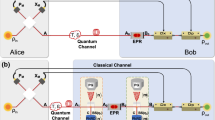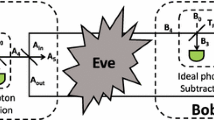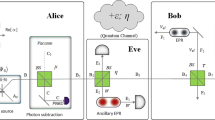Abstract
The transmission performance of continuous-variable quantum key distribution (CVQKD) in turbulent atmospheric channel is lower than CVQKD in fiber channel due to the large loss of quantum entanglement in turbulent atmospheric channel. In this paper, we propose a new approach to prolong the transmission performance of CVQKD in a turbulent atmospheric channel by using photon subtraction operation since the proposed approach can effectively enhance the entangled state between quantum. Simulation analysis shows that photon subtraction operation can effectively improve the security key rate of continuous-variable quantum key distribution, and the optimal performance can be achieved when only one photon is subtracted.







Similar content being viewed by others
References
Wootters, W.K., Zurek, W.H.: A single quantum cannot be cloned. Nature 299(5886), 802–803 (1982)
Bang, J.Y., Berger, M.S.: Quantum mechanics and the generalized uncertainty principle. Phys. Rev. D 74(12), 125012 (2006)
Gisin, N., Ribordy, G., Tittel, W., Zbinden, H.: Quantum cryptography. Rev. Mod. Phys. 74(1), 145 (2002)
Scarani, V., Bechmann-Pasquinucci, H., Cerf, N.J., Dušek, M., Lütkenhaus, N., Peev, M.: The security of practical quantum key distribution. Rev. Mod. Phys. 81(3), 1301 (2009)
Gabay, M., Arnon, S.: Quantum key distribution by a free-space mimo system. J. Lightwave Tech. 24(8), 3114–3120 (2006)
Djordjevi, I.B.: Integrated optics modules based proposal for quantum information processing, teleportation, qkd, and quantum error correction employing photon angular momentum. IEEE Photonics J. 8(1), 1–12 (2016)
Xiao, H., Zhang, Z.: Subcarrier multiplexing multiple-input multiple-output quantum key distribution scheme with orthogonal quantum states. Quantum Inf. Process. 16(1), 13 (2017)
Ursin, R., Tiefenbacher, F., Schmitt-Manderbach, T., Weier, H., Scheidl, T., Lindenthal, M., Blauensteiner, B., Jennewein, T., Perdigues, J., Trojek, P., Ömer, B.: Entanglement-based quantum communication over 144 km. Nat. Phys. 3(7), 481 (2007)
Buttler, W.T., Hughes, R.J., Lamoreaux, S.K., Morgan, G.L., Nordholt, J.E., Peterson, C.G.: Daylight quantum key distribution over 1.6 km. Phys. Rev. Lett. 84(24), 5652 (2000)
Hughes, R.J., Nordholt, J.E., Derkacs, D., Peterson, C.G.: Practical free-space quantum key distribution over 10 km in daylight and at night. New. J. Phys. 4(1), 43 (2002)
Schmitt-Manderbach, T., et al.: Experimental demonstration of free-space decoy-state quantum key distribution over 144 km. Phys. Rev. Lett. 98(1), 010504 (2007)
Fedrizzi, A., Ursin, R., Herbst, T., Nespoli, M., Prevedel, R., Scheidl, T., Tiefenbacher, F., Jennewein, T., Zeilinger, A.: High-fidelity transmission of entanglement over a high-loss free-space channel. Nat. Phys. 5(6), 389 (2009)
Yin, J., Ren, J.G., Lu, H., Cao, Y., Yong, H.L., Wu, Y.P., Liu, C., Liao, S.K., Zhou, F., Jiang, Y., Cai, X.D.: Quantum teleportation and entanglement distribution over 100-kilometre free-space channels. Nature (London) 488(7410), 185 (2012)
Nauerth, S., Moll, F., Rau, M., Fuchs, C., Horwath, J., Frick, S., Weinfurter, H.: Air-to-ground quantum communication. Nat. Photonics 7(5), 382 (2013)
Rarity, J.G., Tapster, P.R., Gorman, P.M., Knight, P.: Ground to satellite secure key exchange using quantum cryptography. New J. Phys. 4(1), 82 (2002)
Aspelmeyer, M., Jennewein, T., Pfennigbauer, M., Leeb, W.R., Zeilinger, A.: Long-distance quantum communication with entangled photons using satellites. IEEE J. Sel. Quantum Electron. 9(6), 1541–1551 (2003)
Villoresi, P., Jennewein, T., Tamburini, F., Aspelmeyer, M., Bonato, C., Ursi, R., Pernechele, C., Luceri, V., Bianco, G., Zeilinger, A., Barbieri, C.: Experimental verification of the feasibility of a quantum channel between space and earth. New J. Phys. 10(3), 033038 (2008)
Armengol, J.M.P., Furch, B., de Matos, C.J., Minster, O., Cacciapuoti, L., Pfennigbauer, M., Aspelmeyer, M., Jennewein, T., Ursin, R., Schmitt-Manderbach, T., Baister, G.: Quantum communications at esa: towards a space experiment on the iss. Acta Astronaut. 63(1-4), 165–178 (2008)
Bonato, C., Tomaello, A., Da Deppo, V., Naletto, G., Villoresi, P.: Feasibility of satellite quantum key distribution. New J. Phys. 11(4), 045017 (2009)
Meyer-Scott, E., Yan, Z., MacDonald, A., Bourgoin, J.P., Hübel, H., Jennewein, T.: How to implement decoy-state quantum key distribution for a satellite uplink with 50-db channel loss. Phys. Rev. A 84(6), 062326 (2011)
Semenov, A.A., Vogel, W.: Quantum light in the turbulent atmosphere. Phys. Rev. A 80(2), 021802 (2009)
Erven, C., Heim, B., Meyer-Scott, E., Bourgoin, J.P., Laflamme, R., Weihs, G., Jennewein, T.: Studying free-space transmission statistics and improving free-space quantum key distribution in the turbulent atmosphere. New J. Phys. 14(12), 123018 (2012)
Capraro, I., Tomaello, A., Dall’Arche, A., Gerlin, F., Ursin, R., Vallone, G., Villoresi, P.: Impact of turbulence in long range quantum and classical communications. Phys. Rev. Lett 109(20), 200502 (2012)
Guo, Y., Xie, C., Huang, P., Li, J., Zhang, L., Huang, D.: Entanglement-distillation attack on continuous-variable quantum key distribution in a turbulent atmospheric channel. Phys. Rev. A 96(2), 022320 (2017)
Y. Guo, Xie, C., Huang, P., Li, J., Zhang, L., Huang, D., Zeng, G.: Channel-parameter estimation for satellite-to-submarine continuous-variable quantum key distribution . Phys. Rev. A 97(5), 052326 (2018)
Zhao, Y., Fung, C.H.F., Qi, B., Chen, C., Lo, H.K.: Quantum hacking: experimental demonstration of time-shift attack against practical quantum-key-distribution systems. Phys. Rev. A 78(4), 042333 (2008)
Lydersen, L., Wiechers, C., Wittmann, C., Elser, D., Skaar, J., Makarov, V.: Hacking commercial quantum cryptography systems by tailored bright illumination. Nat. Photonics 4(10), 686 (2010)
Kim, M.S., Park, E., Knight, P.L., Jeong, H.: Nonclassicality of a photon-subtracted gaussian field. Phys. Rev. A 71(4), 043805 (2005)
Kitagawa, A., Takeoka, M., Sasaki, M., Chefles, A.: Entanglement evaluation of non-gaussian states generated by photon subtraction from squeezed states. Phys. Rev. A 73(4), 042310 (2006)
Navarrete-Benlloch, C., García-Patrón, R., Raúl, Shapiro, J.H., Cerf, Nicolas, J.: Enhancing quantum entanglement by photon addition and subtraction. Phys. Rev. A 86(1), 012328 (2012)
Opatrnỳ, T., Kurizki, G., Welsch, D.G.: Improvement on teleportation of continuous variables by photon subtraction via conditional measurement. Phys. Rev. A 61(3), 032302 (2000)
Zunino, L., Gulich, D., Funes, G., Pérez, D.G.: Turbulence-induced persistence in laser beam wandering. Opt. Lett. 40(13), 3145–3148 (2015)
Berman, G.P., Chumak, A.A., Gorshkov, V.N.: Beam wandering in the atmosphere: the effect of partial coherence. Phys. Rev. E 76(5), 056606 (2007)
Madsen, L.S., Usenko, V.C., Lassen, M., Filip, R., Andersen, U.L.: Continuous variable quantum key distribution with modulated entangled states. Nat. Commun. 3, 1083 (2012)
Franzen, A., Hage, B., DiGuglielmo, J., Fiurasek, J., Schnabel, R.: Experimental demonstration of continuous variable purification of squeezed states. Phys. Rev. Lett. 97(15), 150505 (2006)
Gottesman, D., Preskill, J.: Secure quantum key distribution using squeezed states. In: Quantum Information with Continuous Variables, vol. 63, pp. 022309. Springer (2001)
Acknowledgements
This work was supported by the National Natural Science Foundation of China (Grant Nos. 61572529, 61871407, 61872390, 61801522), and the Natural Science Foundation of the Jiangsu Higher Education Institutions of China (Grant No. 18KJB510045).
Author information
Authors and Affiliations
Corresponding author
Additional information
Publisher’s Note
Springer Nature remains neutral with regard to jurisdictional claims in published maps and institutional affiliations.
Appendices
Appendix A: Two-Mode Squeezed State
Recently, researchers have proposed CVQKD protocol for preparing entangled states [34,35,36]. The most widely used are the Gauss quantum continuous variable prepared for the single-mode vacuum squeezed state or the two-mode vacuum squeezed state. The correlation matrix in the single-mode vacuum compression state can be expressed as
where the average value of the state are zero, and the r is squeezing factor. When r > 0, it means that the x is squeezed, otherwise p is squeezed. In this paper, we consider the two-mode vacuum squeezed state based on the Einstein-Podolsky-Rosen (EPR) states. Finally we have the covariance matrix of the state given by
where \(\mathbb {I}\) and \(\mathbb {Z}\) correspond to matrix diag(1,1) and matrix diag(1,− 1), respectively. We take \(\gamma _{AB_{0}}\) to describe the combination of two rotated squeezed vacuum states(EPR state) on a balanced beam splitter. Consequently, \(\gamma _{AB_{0}}\) can be calculated as
where \(V =\left (V_{A}+V_{S} \right )/2\) is Alice’s modulation variance, VA is for the antisqueezed state and VS is for the squeezed state. Therefore, we have the symbols
In this scheme, Alice applies two squeezers on the balanced beam splitter to produce a quantum two-mode squeezed state. Then she performs measurements on one mode of them and sends the other mode to Bob. Alice and Bob transmit measurement parameters over the classic channel and establish the secret key after using privacy amplification.
Appendix B: Heterodyne and Homodyne Detection
In homodyne detection case, Bob performs a homodyne detection on the received information, the mutual information \(I_{AB}^{Hom}\) (I(A:B) is expressed as \(I_{(A:B)}^{Hom}\)) between Alice and Bob can be evaluated as
In addition, \(S_{(A|B)}^{Hom}\) (S(A|B) is expressed as \(S_{(A|B)}^{Hom}\)) can be calculated as \(S_{(A|B)}^{Hom}=G\left (\frac {\lambda _{3}-1}{2} \right ) \), where the simplistic eigenvalues \({\lambda _{3}^{2}}(Hom) = a(a-\frac {c^{2}}{b})\). When Bob uses the homodyne detection, the resulting secret key rate is finally expressed as
In heterodyne detection case, when Bob performs a heterodyne detection on the received information, the mutual information \(I_{AB}^{Het}\) (I(A:B) is expressed as \(I_{(A:B)}^{Het}\)) between Alice and Bob can be evaluated as
Subsequently, \(S_{(A|B)}^{Het}\) (S(A|B) is expressed as \(S_{(A|B)}^{Het}\)) can be calculated as
where the simplistic eigenvalues are given by
When Bob applies the heterodyne detection, the resulting secret key rate is expressed as
Rights and permissions
About this article
Cite this article
Peng, Q., Liao, Q. & Guo, Y. Improving Continuous-Variable Quantum Key Distribution in a Turbulent Atmospheric Channel via Photon Subtraction. Int J Theor Phys 59, 338–349 (2020). https://doi.org/10.1007/s10773-019-04327-w
Received:
Accepted:
Published:
Issue Date:
DOI: https://doi.org/10.1007/s10773-019-04327-w




